What is an Animal Cell?
- An animal cell is a fundamental unit of life that comprises various structures enclosed by a flexible plasma membrane. It lacks a rigid cell wall, allowing for diverse shapes and specialized functions within multicellular organisms.
- Being eukaryotic in nature, animal cells contain a well-defined nucleus that houses genetic material in the form of DNA. This nucleus regulates cellular activities and ensures the proper transmission of genetic information during cell division.
- The cytoplasm, a gel-like substance filling the cell interior, hosts numerous organelles responsible for vital cellular processes. Mitochondria within the cytoplasm generate energy through cellular respiration, providing the necessary power for various cellular functions.
- Besides energy production, the endoplasmic reticulum plays a crucial role in synthesizing and transporting proteins and lipids. The rough endoplasmic reticulum is studded with ribosomes that facilitate protein synthesis, whereas the smooth endoplasmic reticulum is involved in lipid production and detoxification processes.
- The Golgi apparatus functions as the cell’s packaging and distribution center, modifying proteins and lipids before dispatching them to their designated locations. Therefore, it ensures that essential molecules reach their target sites efficiently and accurately.
- Lysosomes serve as the cell’s digestive system by breaking down waste materials and cellular debris. These organelles contain hydrolytic enzymes that degrade complex molecules, maintaining cellular cleanliness and health.
- Then, we have peroxisomes that detoxify harmful substances and aid in lipid metabolism. They play a significant role in protecting the cell from oxidative damage by neutralizing free radicals.
- The cytoskeleton provides structural support and facilitates movement within the cell. Comprising microtubules, microfilaments, and intermediate filaments, it maintains cell shape and assists in intracellular transport and cellular division.
- Cellular communication and interaction with the external environment are mediated through the plasma membrane. This semi-permeable barrier controls the ingress and egress of substances, thereby maintaining homeostasis and responding to external stimuli effectively.
- In contrast to plant cells, animal cells do not possess chloroplasts or a central vacuole. This distinction underscores their inability to perform photosynthesis and influences their modes of nutrition and energy acquisition.
Definition of animal cell
An animal cell is a eukaryotic cell characterized by a flexible plasma membrane, a nucleus containing DNA, and various organelles that perform essential cellular functions. Unlike plant cells, it lacks a rigid cell wall, allowing for diverse shapes and specialized structures within multicellular organisms.
Facts about Animal Cells
- Eukaryotic Nature: Most animal cells are eukaryotic, meaning they contain a nucleus that houses the cell’s genetic material. However, red blood cells are an exception, as they lack a nucleus to maximize space for hemoglobin, which is crucial for oxygen transport.
- Cell Movement: Certain animal cells have the ability to move. For example, sperm cells, which carry the male gamete, can swim towards the female ova in the uterus to enable fertilization. Protozoa, another type of cell, also exhibit this capability.
- Totipotency in Stem Cells: Mammalian stem cells are totipotent, indicating their ability to differentiate into any cell type required by the body. This property is fundamental for growth, repair, and development.
- Self-Repair Mechanisms: Animal cells possess the ability to repair minor DNA and RNA strand breaks that occur during normal cellular processes. If the damage is too severe, the cell may initiate a self-destruct mechanism, known as apoptosis, to prevent harm to surrounding cells.
- Cell Composition: Water constitutes approximately 70% of an animal cell, with the remaining 30% made up of organic molecules such as carbohydrates, proteins, and lipids. These components are essential for maintaining cellular functions.
- Internal Chemical Factories: Animal cells contain complex chemical factories, such as ribosomes and mitochondria, that produce the necessary molecules and energy required for cellular activities.
- Invisibility to the Naked Eye: Like human cells, animal cells are microscopic and cannot be seen without the aid of a microscope.
- Cytoskeleton Function: The cytoskeleton, located in the cytoplasm, provides structural support to the cell, maintaining its shape and facilitating movement and intracellular transport.
- Nucleus Location: Contrary to popular belief, the nucleus is not always centrally located within the cell. Its position can vary depending on the specific type and function of the cell.
- Plasma Membrane Receptors: Animal cells have plasma membranes rich in receptors, which are protein structures that respond to external stimuli by transmitting candidates signals into the cell. These receptors play a crucial role in cellular communication and are vital in processes like drug action.
- Photoreceptors in Vision: Within the eye, rod and cone cells act as photoreceptors, aiding in vision. Rod cells, in particular, are highly sensitive and can be triggered by a single photon, which explains the superior night vision of animals like cats, whose retinas are much more sensitive than those of humans.
- Phagocytosis: Certain white blood cells, such as neutrophils and macrophages, have the ability to consume harmful pathogens through a process known as phagocytosis. Neutrophils target pathogens in the bloodstream, while macrophages do so within tissues, using lysosomal enzymes to break down ingested bacteria.
- ATP Production: Animal cells generate adenosine triphosphate (ATP), a molecule that converts oxygen into energy, enabling the cell to perform vital functions necessary for the organism’s survival.
Size and shape of Animal cell
The size and shape of animal cells are varied and intricate, reflecting their specialized functions within the organism. Here are some key points about the size and shape of animal cells:
- Diverse Range of Sizes: Animal cells exhibit a wide range of sizes, typically measured in micrometers (µm). The size of animal cells can vary significantly, with some as large as a few millimeters, such as the ostrich egg cell, which is the largest known animal cell with a diameter of about 5 inches and weighing approximately 1.2-1.4 kilograms. On the other end of the spectrum, some of the smallest animal cells, like neurons, measure around 100 microns in diameter.
- Smaller than Plant Cells: Generally, animal cells are smaller than plant cells. This size difference is partly due to the absence of a rigid cell wall in animal cells, which allows for more flexibility in shape and structure.
- Variety of Shapes: The shape of animal cells is highly variable and depends on their specific function within the organism. Due to the lack of a cell wall, animal cells can adopt various shapes, such as round, oval, flattened, rod-shaped, spherical, concave, or rectangular. This flexibility in shape allows animal cells to perform diverse functions, from forming the intricate structures of tissues to enabling movement and interaction with the environment.
- Microscopic Nature: Most animal cells are microscopic and cannot be observed with the naked eye. They require a microscope to study their anatomy and understand their structure. This microscopic size enables the cells to efficiently manage the exchange of materials, such as nutrients and waste, across the plasma membrane.
- Shared Eukaryotic Features: Despite the differences in size and shape, animal cells share several key features with plant cells, as both evolved from eukaryotic ancestors. Animal cells possess a membrane-bound nucleus that houses the genetic material in the form of DNA. In addition, they contain various cellular organelles, such as mitochondria, the Golgi apparatus, and endoplasmic reticulum, all enclosed within the plasma membrane. These organelles perform specialized functions essential for the cell’s survival and overall functioning of the organism.
- Functional Implications: The size and shape of an animal cell are closely linked to its function. For example, nerve cells (neurons) are elongated to facilitate the transmission of electrical signals over long distances, while red blood cells are concave to maximize surface area for oxygen transport. This emphasis on function underscores the adaptive nature of animal cells in responding to the organism’s needs.
Types of Animal Cell
Animal cells exhibit a remarkable diversity in form and function, each type specialized to carry out specific tasks within the body. Here is an overview of the various types of animal cells:
- Skin Cells (Epithelial Cells):
- Function: Skin cells, or epithelial cells, form the outermost layer of the body, providing a protective barrier against environmental factors such as pathogens, chemicals, and physical injuries. They also play a role in absorption, secretion, and sensation.
- Structure: These cells are tightly packed and held together by cell junctions, including tight junctions, which prevent the passage of substances between cells, and desmosomes, which provide mechanical strength.
- Muscle Cells (Myocytes):
- Function: Muscle cells, also known as myocytes, are responsible for producing force and motion. They make up the muscular tissue, which is essential for body movements, maintaining posture, and generating heat through muscle contractions.
- Structure: Muscle cells are elongated and contain specialized proteins like actin and myosin, which interact to produce contraction. These cells can be classified into three types: skeletal, cardiac, and smooth muscle cells, each adapted for specific functions in the body.
- Blood Cells:
- Function: Blood cells are the cellular components of blood and include red blood cells (erythrocytes) and white blood cells (leukocytes). Red blood cells are responsible for transporting oxygen from the lungs to tissues throughout the body, while white blood cells are crucial for immune defense against infections and foreign invaders.
- Structure: Red blood cells are biconcave and lack a nucleus, optimizing them for oxygen transport. White blood cells, on the other hand, have a nucleus and can vary in shape depending on their specific function in the immune system.
- Fat Cells (Adipocytes):
- Function: Fat cells, or adipocytes, store energy in the form of lipids and provide insulation and cushioning to protect organs. They also play a role in hormone production, particularly in regulating metabolism and appetite.
- Structure: Adipocytes are characterized by a large lipid droplet that occupies most of the cell’s volume, pushing the nucleus to the periphery. They can expand or shrink depending on the body’s energy needs.
- Nerve Cells (Neurons):
- Function: Nerve cells, also known as neurons, are the building blocks of the nervous system. They are responsible for transmitting electrical and chemical signals throughout the body, enabling functions such as sensation, thought, movement, and reflexes.
- Structure: Neurons have a unique structure that includes a cell body (soma), dendrites that receive signals, and an axon that transmits signals to other cells. The myelin sheath, a fatty layer surrounding the axon, speeds up signal transmission.
- Sex Cells (Gametes):
- Function: Sex cells, or gametes, are involved in sexual reproduction. In males, the sperm cell is the functional gamete, while in females, the egg cell (ovum) plays this role. These cells carry half the genetic material (haploid) necessary to form a new organism upon fertilization.
- Structure: Sperm cells are small and motile, equipped with a flagellum that allows them to swim toward the egg cell. Egg cells, in contrast, are larger and contain the nutrients necessary for the early development of the embryo.
- Stem Cells:
- Function: Stem cells are totipotent or pluripotent cells, meaning they have the potential to differentiate into any type of cell in the body. They are vital for growth, development, and tissue repair, as they can generate new cells to replace damaged or lost ones.
- Structure: Stem cells are relatively undifferentiated, with a simple structure that allows them to divide and produce various specialized cells. Depending on their potency, they may differentiate into specific cell types or remain as stem cells.
Animal Cell Diagram and Structure (cross section of an animal cell)
The cell of the animal is composed of a variety of structural organelles that are enclosed within the plasma membrane. These organelles allow it to function effectively by triggering mechanisms that are beneficial to those who are the hosts (animal). The interaction of all cells provides an animal the capacity to move, reproduce as well as respond to stimuli in a way, take in and digest food, etc. In general, the effort put forth of all animal cells is what provides the regular working of the human body.
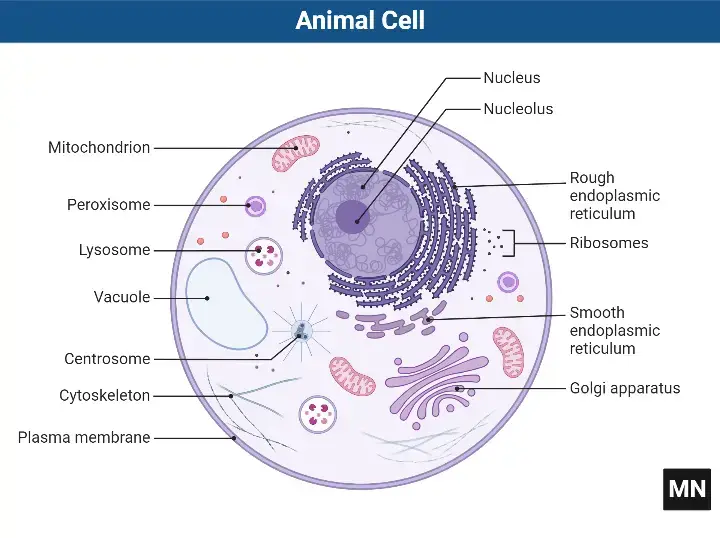
List of Animal cell organelles
Animal cells contain various organelles, each with specialized functions that contribute to the cell’s overall operation. Here is a comprehensive list of key organelles found in animal cells:

- Plasma Membrane (Cell Membrane):
- Function: The plasma membrane acts as a protective barrier, regulating the movement of substances into and out of the cell. It maintains the cell’s integrity and facilitates communication with other cells.
- Structure: Composed of a phospholipid bilayer with embedded proteins, it provides flexibility and fluidity to the cell while maintaining a selectively permeable nature.
- Nucleus:
- Function: The nucleus serves as the control center of the cell, housing the cell’s genetic material (DNA). It regulates gene expression, cell growth, and reproduction.
- Structure: The nucleus is surrounded by a double membrane called the nuclear envelope, which contains nuclear pores for the exchange of materials. Inside, the nucleolus is responsible for ribosome synthesis.
- Cytoplasm:
- Function: The cytoplasm is a gel-like substance that fills the cell, providing a medium for chemical reactions and holding the organelles in place.
- Structure: Composed mainly of water, salts, and proteins, the cytoplasm includes the cytosol (fluid component) and the organelles suspended within it.
- Mitochondria:
- Function: Mitochondria are the powerhouses of the cell, generating ATP (adenosine triphosphate) through cellular respiration. They supply energy necessary for various cellular processes.
- Structure: Mitochondria have a double membrane, with the inner membrane folded into cristae to increase surface area for energy production.
- Ribosomes:
- Function: Ribosomes are the sites of protein synthesis, where amino acids are assembled into proteins based on the genetic instructions from the nucleus.
- Structure: Ribosomes can be found floating freely in the cytoplasm or attached to the endoplasmic reticulum. They are composed of rRNA (ribosomal RNA) and proteins.
- Endoplasmic Reticulum (ER):
- Function: The ER is involved in the synthesis, folding, modification, and transport of proteins and lipids. It is divided into two types: rough ER, studded with ribosomes, and smooth ER, which lacks ribosomes and is involved in lipid synthesis and detoxification.
- Structure: The ER is a network of membranous tubules and sacs that extend from the nuclear envelope throughout the cytoplasm.
- Golgi Apparatus (Golgi Bodies/Golgi Complex):
- Function: The Golgi apparatus modifies, sorts, and packages proteins and lipids for secretion or delivery to other organelles. It plays a crucial role in processing macromolecules synthesized in the cell.
- Structure: Composed of flattened membranous sacs called cisternae, the Golgi apparatus works closely with the ER to ensure proper protein and lipid handling.
- Lysosomes:
- Function: Lysosomes are the digestive organelles of the cell, breaking down waste materials, cellular debris, and foreign invaders like bacteria through enzymatic reactions.
- Structure: Lysosomes are membrane-bound vesicles containing hydrolytic enzymes that function optimally at acidic pH levels.
- Cytoskeleton:
- Function: The cytoskeleton provides structural support to the cell, facilitating movement, maintaining shape, and organizing the cell’s internal structure.
- Structure: Composed of microfilaments, intermediate filaments, and microtubules, the cytoskeleton is a dynamic network of protein fibers.
- Microtubules:
- Function: Microtubules are part of the cytoskeleton and are involved in maintaining cell shape, facilitating intracellular transport, and forming the spindle fibers during cell division.
- Structure: Microtubules are hollow tubes made of tubulin proteins, forming a scaffold within the cell.
- Centrioles:
- Function: Centrioles play a critical role in organizing microtubules during cell division, helping to form the mitotic spindle that separates chromosomes.
- Structure: Centrioles are cylindrical structures made of microtubules arranged in a specific pattern, typically found in pairs near the nucleus.
- Peroxisomes:
- Function: Peroxisomes are involved in the breakdown of fatty acids and the detoxification of harmful substances. They produce hydrogen peroxide as a byproduct, which is then broken down by the enzyme catalase.
- Structure: Peroxisomes are small, membrane-bound organelles containing oxidative enzymes.
- Cilia and Flagella:
- Function: Cilia and flagella are hair-like structures that extend from the cell surface and are involved in cell movement and the movement of substances across the cell surface.
- Structure: Cilia are short and numerous, while flagella are longer and usually singular. Both are composed of microtubules arranged in a 9+2 pattern.
- Endosome:
- Function: Endosomes are involved in the sorting and trafficking of materials brought into the cell via endocytosis. They help in transporting substances to lysosomes or recycling them back to the plasma membrane.
- Structure: Endosomes are membrane-bound vesicles that form through the invagination of the plasma membrane.
- Vacuoles:
- Function: In animal cells, vacuoles are small and primarily involved in storage and transport of substances. They also help in maintaining osmotic balance.
- Structure: Vacuoles are membrane-bound sacs that contain fluids, ions, and other materials.
- Microvilli:
- Function: Microvilli are small, finger-like projections of the plasma membrane that increase the surface area for absorption and secretion.
- Structure: Microvilli are supported by a core of actin filaments and are commonly found on the surface of cells involved in absorption, such as in the intestines.
Plasma membrane (Cell membrane)
The plasma membrane, often referred to as the cell membrane, is a thin, semipermeable barrier that encapsulates the contents of an animal cell. This membrane serves as the interface between the cell’s interior and its external environment, playing a crucial role in maintaining the cell’s structural integrity and facilitating communication and transport.
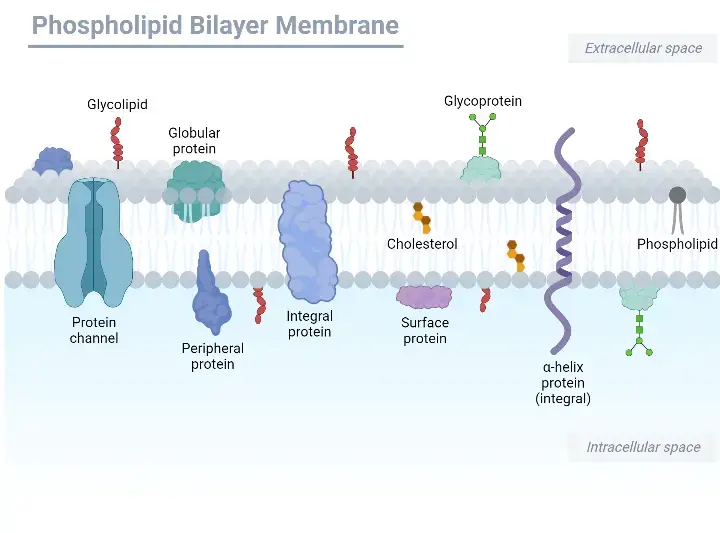
Structure of the Plasma Membrane:
- Thin Semipermeable Membrane:
- The plasma membrane is a selectively permeable structure that allows specific molecules to enter or exit the cell while preventing others from passing through. This selective permeability is fundamental to the membrane’s function in regulating the internal environment of the cell.
- Lipid Bilayer:
- Composition: The plasma membrane primarily consists of a lipid bilayer, made up of phospholipids, which form a hydrophobic (water-repelling) barrier. This bilayer is responsible for the membrane’s semipermeable nature, providing a barrier that separates the cell’s interior from the external environment.
- Function: The lipid bilayer prevents free passage of water-soluble substances, ensuring that the cell’s internal environment remains distinct from its surroundings.
- Protein Components:
- Embedded Proteins: The plasma membrane contains various proteins embedded within the lipid bilayer. These proteins serve multiple functions, including transport of materials, signal transduction, and acting as receptors for cellular communication.
- Peripheral and Integral Proteins: Some proteins are attached to the membrane’s surface (peripheral proteins), while others span the membrane (integral proteins), facilitating various interactions and transport mechanisms.
- Consistency and Flexibility:
- The plasma membrane is consistently present around the cell and exhibits fluidity, allowing it to change shape and accommodate different cellular processes, such as endocytosis and exocytosis.
- Carbohydrates:
- Glycoproteins and Glycolipids: Carbohydrate molecules are attached to proteins (glycoproteins) and lipids (glycolipids) on the extracellular surface of the membrane. These carbohydrate chains play a significant role in cell recognition, signaling, and interactions with other cells.
Functions of the Plasma Membrane:
- Enclosure and Protection:
- Barrier Function: The plasma membrane acts as a protective barrier, enclosing the cell’s contents and shielding them from the external environment. This enclosure is vital for maintaining the integrity and stability of the cell’s internal environment.
- Regulation of Transport:
- Selective Permeability: One of the membrane’s primary functions is to regulate the movement of molecules into and out of the cell. This regulation ensures that essential nutrients enter the cell, while waste products and harmful substances are removed.
- Transport Mechanisms: The proteins embedded in the plasma membrane are actively involved in transporting materials across the membrane. This includes facilitated diffusion, active transport, and endocytosis/exocytosis processes.
- Maintenance of Homeostasis:
- Control of Internal Environment: By regulating the passage of molecules, the plasma membrane plays a crucial role in maintaining homeostasis within the cell. It ensures that the cell’s internal conditions remain stable and suitable for vital biochemical processes.
- Cell Communication and Recognition:
- Signal Transduction: The plasma membrane’s proteins and lipids are involved in cell communication, allowing the cell to receive and respond to external signals. This communication is essential for coordinating cellular activities and responding to changes in the environment.
- Cell Recognition: The carbohydrates that decorate the membrane’s proteins and lipids assist in cell recognition, enabling cells to identify and interact with each other. This is particularly important in immune responses and tissue formation.
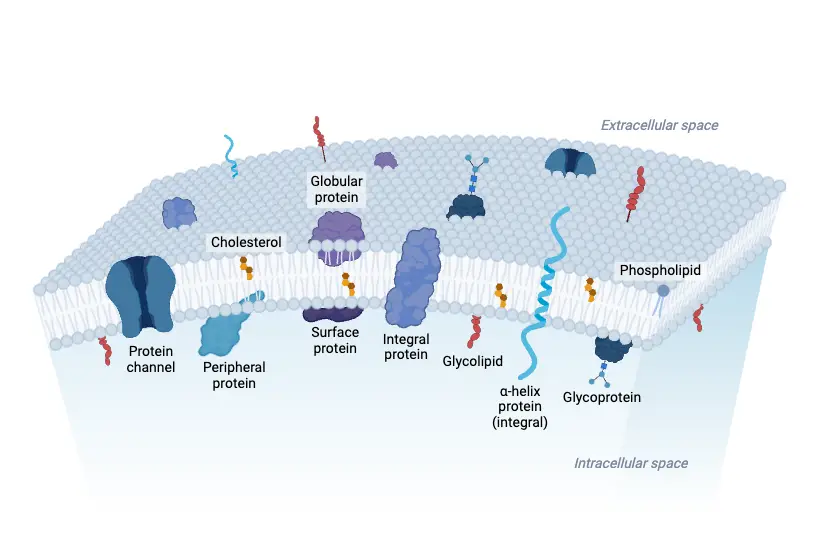
Nucleus
The nucleus is a prominent, spherical organelle found predominantly at the center of most eukaryotic cells. It is enclosed by a double-layered nuclear membrane, which acts as a barrier separating the nucleus from the surrounding cytoplasm. The nucleus serves as the command center of the cell, containing the genetic material and coordinating essential cellular activities, including growth, metabolism, and reproduction.
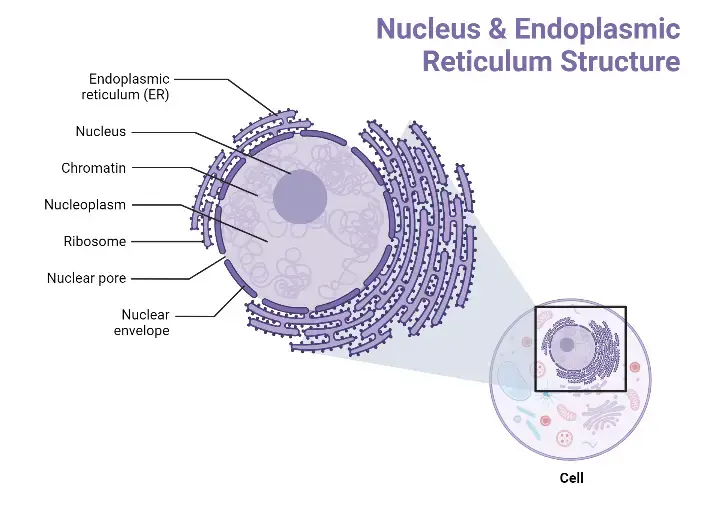
Structure of the Nucleus:
- Nuclear Membrane (Nuclear Envelope):
- Double-Layered Structure: The nuclear membrane is composed of two lipid bilayers that form a continuous barrier around the nucleus. This membrane is an extension of the endoplasmic reticulum network, linking the nucleus to the cell’s broader membrane system.
- Nuclear Pores: The nuclear envelope is perforated with numerous pores, which regulate the passage of large molecules, such as RNA and ribosomal subunits, between the nucleus and the cytoplasm.
- Nucleoplasm:
- Suspension Medium: The interior of the nucleus is filled with nucleoplasm, a viscous fluid that houses the cell’s chromosomal DNA and various nuclear components. The nucleoplasm provides a medium for the suspension and organization of the nucleus’s internal structures.
- Nucleolus:
- Sub-Nuclear Structure: Within the nucleus lies the nucleolus, a dense region responsible for the synthesis and assembly of ribosomal RNA (rRNA) and ribosome subunits. The nucleolus may contain one or more nucleoli, depending on the cell’s activity level.
- Chromatin:
- Genetic Material: The chromatin within the nucleus consists of DNA and associated proteins. It exists in two forms: euchromatin, which is less condensed and actively involved in transcription, and heterochromatin, which is more condensed and generally inactive.
Functions of the Nucleus:
- Control Center of the Cell:
- Regulation of Cellular Activities: The nucleus plays a critical role in regulating cellular activities, including growth, metabolism, and differentiation. It achieves this by controlling the expression of genes and the synthesis of proteins, which are vital for the cell’s functioning.
- Storage of Genetic Information:
- Houses DNA: The nucleus is the repository of the cell’s genetic material, containing the chromosomal DNA that encodes the instructions for all cellular processes. This genetic information is passed on during cell division, ensuring the continuity of genetic traits.
- Site of Transcription:
- mRNA Synthesis: The nucleus is the primary site for the transcription process, where messenger RNA (mRNA) is synthesized from a DNA template. This mRNA is then transported through the nuclear pores to the cytoplasm, where it guides protein synthesis.
- Nucleolus Function:
- Ribosome Production: The nucleolus within the nucleus is essential for producing ribosomes, which are the cellular machinery responsible for protein synthesis. The nucleolus assembles ribosomal subunits from rRNA and proteins, which are then exported to the cytoplasm.
- Genetic Regulation:
- Gene Expression: The chromatin within the nucleus undergoes various modifications that regulate gene expression. By controlling which genes are active or inactive, the nucleus ensures that the cell responds appropriately to internal and external signals.
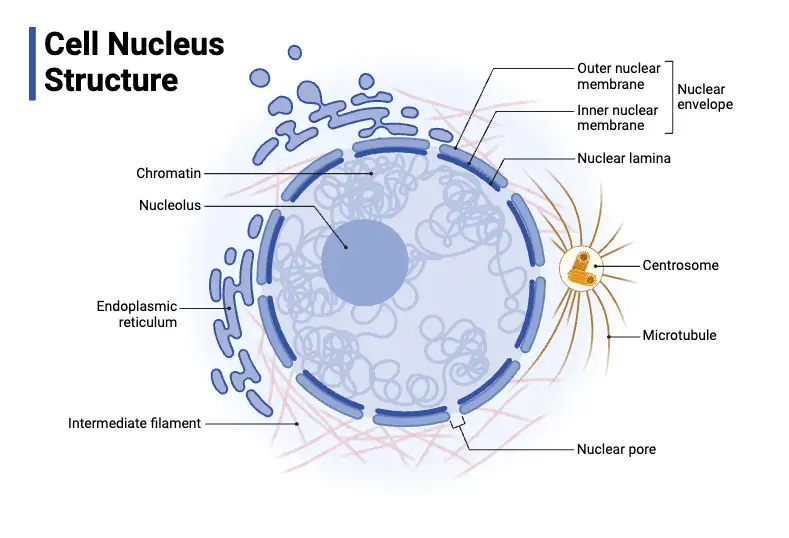
Cytoplasm
The cytoplasm is a gel-like substance that fills the interior of the cell, situated between the cell membrane and the nucleus. It contains all the cell’s organelles and various inclusions, functioning as a medium that supports and facilitates cellular processes.
Structure/Components of the Cytoplasm:
- Cytosol:
- Gel-Like Fluid: The cytosol is the semi-fluid portion of the cytoplasm not occupied by organelles. It is a viscous, gelatinous matrix where various cellular components are suspended.
- Composition: Primarily composed of water, organic molecules, salts, and cytoskeletal filaments. The cytosol provides a medium for metabolic reactions and helps maintain cell shape.
- Organelles:
- Definition: Organelles are membrane-bound structures within the cytoplasm, each performing specific functions crucial for cell survival.
- Mitochondria: Known as the powerhouses of the cell, mitochondria generate ATP through cellular respiration, essential for energy production.
- Endoplasmic Reticulum (ER): The ER is involved in protein and lipid synthesis. The rough ER has ribosomes attached and is involved in protein synthesis, while the smooth ER functions in lipid metabolism and detoxification.
- Golgi Apparatus: This organelle modifies, sorts, and packages proteins and lipids from the ER for secretion or delivery to other organelles.
- Lysosomes: Contain digestive enzymes to break down macromolecules, old cell parts, and pathogens.
- Vacuoles: Store nutrients, waste products, and help maintain turgor pressure in plant cells.
- Chloroplasts (in plant cells): Site of photosynthesis, converting light energy into chemical energy.
- Definition: Organelles are membrane-bound structures within the cytoplasm, each performing specific functions crucial for cell survival.
- Cytoplasmic Inclusions:
- Definition: These are non-membrane-bound particles or molecules suspended in the cytosol, varying by cell type and function.
- Energy Storage Granules: Include starch and glycogen granules that serve as energy reserves.
- Lipid Droplets: Spherical structures composed of lipids and proteins, storing fats and sterols.
- Crystals: Such as calcium oxalate in plants, which may serve as a defense mechanism or waste product storage.
- Definition: These are non-membrane-bound particles or molecules suspended in the cytosol, varying by cell type and function.
Functions of Cytoplasm:
- Site for Metabolic Activities:
- Enzymatic Reactions: The cytoplasm is the venue for most enzymatic reactions, including glycolysis, the initial step of cellular respiration that occurs in the cytosol.
- Cell Expansion and Growth:
- Medium for Organelles: The cytoplasm provides a medium in which organelles are suspended, facilitating their movement and interaction.
- Protection and Support:
- Buffering: Acts as a protective buffer for genetic material and organelles against physical damage from cell movement and collisions with other cells.
- Protein Synthesis:
- Translation: Ribosomes in the cytoplasm translate mRNA into proteins, essential for various cellular functions.
- Cytoskeleton Formation:
- Structural Support: Contains the monomers required for the formation of the cytoskeleton, which maintains cell shape, supports organelles, and aids in intracellular transport.
- Order and Organization:
- Spatial Arrangement: Helps organize the cell’s internal structure, positioning organelles like the nucleus centrally and ensuring functional efficiency.
- Cytoplasmic Streaming:
- Nutrient Distribution: Facilitates the movement of chloroplasts towards light in plant cells and aids in nutrient distribution in various cell types.
- Cytoplasmic Inheritance:
- Organelle Replication: Hosts organelles with their own genomes, such as mitochondria and chloroplasts, which replicate independently of the nucleus and contribute to maternal inheritance.

Ribosomes
Ribosomes are essential organelles found in all living cells, integral to the process of protein synthesis. They consist of ribosomal RNA (rRNA) and proteins and can be either freely floating in the cytoplasm or attached to the endoplasmic reticulum (ER).

Structure of Ribosomes:
- Composition:
- RNA and Protein Ratio: Ribosomes are composed of approximately 60% ribosomal RNA and 40% ribosomal proteins.
- Subunits: Ribosomes are organized into two distinct subunits:
- Large Subunit (60S): This subunit has a larger size and performs crucial functions in peptide bond formation.
- Small Subunit (40S): The smaller subunit is responsible for reading the mRNA and ensuring proper alignment of the tRNA.
- Eukaryotic Ribosomes:
- Structure: In eukaryotic cells, ribosomes are roughly equal parts rRNA and proteins. They exist as separate large and small subunits that combine during protein synthesis.
Functions of Ribosomes:
- Protein Synthesis:
- Location: Ribosomes are either free in the cytoplasm or bound to the endoplasmic reticulum, forming rough ER. Collectively, these ribosomes make up about 25% of a cell’s organelles.
- Protein Assembly: Ribosomes translate genetic information from mRNA into proteins. They facilitate the binding of transfer RNA (tRNA), which carries specific amino acids corresponding to the mRNA code.
- Peptide Bond Formation: The ribosomal rRNA, through the catalytic activity of peptidyl transferase, forms peptide bonds between amino acids, creating polypeptide chains that eventually fold into functional proteins.
- Genetic Coding and Translation:
- mRNA and tRNA Interaction: mRNA serves as a template for ribosomes to determine the sequence of amino acids in a protein. tRNA molecules match their amino acids to the mRNA codons, ensuring accurate protein synthesis.
- Protein Detachment and Transport: After synthesis, newly formed proteins are released from ribosomes and transported to various cellular compartments for further processing or function.
Additional Details:
- Quantitative Presence:
- Cellular Abundance: A single eukaryotic cell may contain up to 10 million ribosomes, reflecting their crucial role in cellular function and the high demand for protein synthesis.
- Role in Cellular Processes:
- Ribosome Functionality: Ribosomes are central to cellular metabolism, influencing the production of enzymes, structural proteins, and other essential molecules.
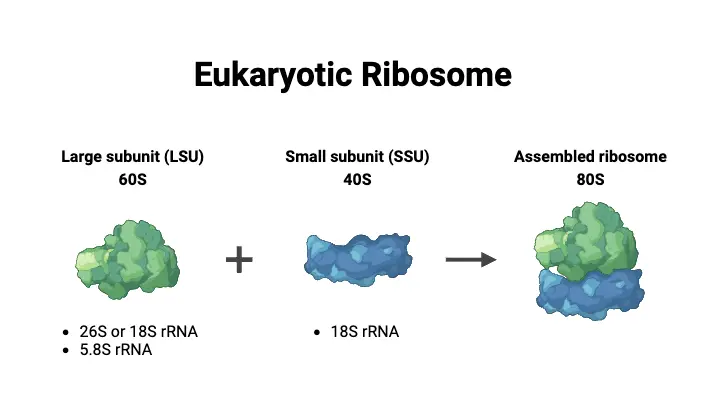
Mitochondria
Mitochondria are membrane-bound organelles located within the cytoplasm of eukaryotic cells. They are integral to cellular energy production and exhibit considerable variation in number and structure based on cell function.

Structure of Mitochondria:
- Shape and Size:
- Variety in Form: Mitochondria can appear rod-shaped, oval, or spherical, with sizes ranging from 0.5 to 10 μm.
- Membrane Organization: Each mitochondrion is enclosed by two distinct membranes: an outer membrane and an inner membrane.
- Membrane Details:
- Outer Membrane: The outer membrane is permeable, allowing the passage of small molecules and ions. It contains channels that facilitate the transport of larger molecules.
- Inner Membrane: This membrane is less permeable and folds inward to form structures known as cristae. These folds increase the surface area for chemical reactions.
- Matrix:
- Gel Matrix: The central region of the mitochondrion, known as the mitochondrial matrix, contains mitochondrial DNA and various enzymes required for metabolic processes, including the Tricarboxylic Acid (TCA) cycle, also known as the Krebs cycle.
Functions of Mitochondria:
- Energy Production:
- ATP Synthesis: Mitochondria are often described as the “powerhouses” of the cell due to their role in generating Adenosine Triphosphate (ATP), the primary energy carrier in cells. This process occurs through the conversion of nutrients and oxygen into ATP.
- Electron Transport Chain (ETC): The inner mitochondrial membrane houses the ETC, a series of protein complexes involved in oxidative phosphorylation. This process includes a sequence of oxidation-reduction reactions that transport electrons and drive ATP synthesis.
- Calcium Storage and Signaling:
- Calcium Regulation: Mitochondria help regulate cellular calcium levels, which is crucial for various signaling pathways and cellular functions.
- Heat Generation and Cellular Regulation:
- Heat Production: Mitochondria contribute to cellular and mechanical heat generation.
- Apoptosis: They play a role in programmed cell death (apoptosis), which is critical for maintaining cellular homeostasis.
- Metabolic Intermediates:
- TCA Cycle: The TCA cycle within the mitochondrial matrix converts nutrients into by-products used for ATP production.
- Mitochondrial DNA (mtDNA):
- Genetic Material: Mitochondria contain their own DNA, which encodes 37 genes essential for mitochondrial function. Thirteen of these genes are involved in producing components of the ETC.
- Inheritance and Mutations: Mitochondrial DNA is inherited maternally and is susceptible to mutations due to its limited DNA repair mechanisms. Mutations in mtDNA can lead to various diseases and contribute to aging and cancer.
Additional Insights:
- Reactive Oxygen Species (ROS):
- Free Radicals: Mitochondria produce reactive oxygen species (ROS) as by-products of metabolism. Excessive ROS can damage mitochondrial DNA and other cellular components. Antioxidant proteins within mitochondria mitigate some of this damage, but excessive ROS, often exacerbated by alcohol consumption, can lead to cellular damage and disease.
- Maternal Inheritance:
- Inheritance Pattern: Mitochondria are inherited from the mother, as the sperm’s mitochondria are typically destroyed during fertilization. This maternal inheritance is linked to various mitochondrial diseases, including Alzheimer’s and Parkinson’s diseases.
- Role in Disease:
- Disease Association: Mutations in mtDNA and subsequent mitochondrial dysfunction are associated with several diseases and conditions, including neurodegenerative disorders and certain cancers.
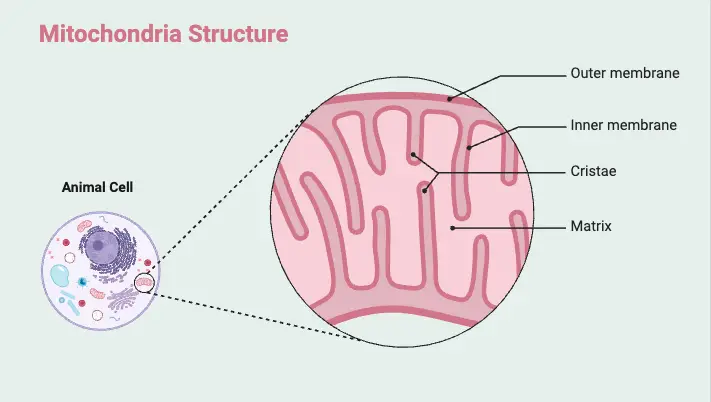
Endoplasmic Reticulum (ER)
The Endoplasmic Reticulum (ER) is a crucial membranous organelle in eukaryotic cells, involved in various cellular processes including protein and lipid synthesis. It forms an extensive network of interconnected membranous sacs and tubules that extend throughout the cytoplasm and connect to the nuclear membrane.
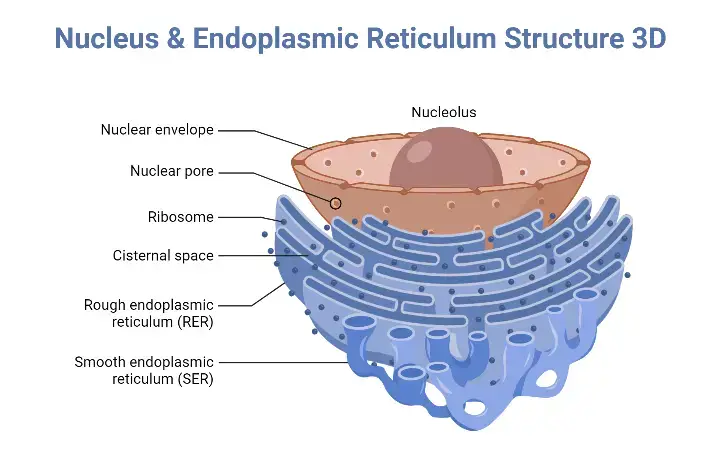
Structure of Endoplasmic Reticulum (ER)
- General Structure:
- Membranous Network: The ER consists of a continuous, folded network of membranes that connect the cytoplasm to the nucleus. These membranes form a system of flattened sacs and tubules.
- Cristae: Within the ER, membrane folds known as cristae create membranous spaces. These structures are essential for its functional activities.
- Types of Endoplasmic Reticulum:
- Rough Endoplasmic Reticulum (Rough ER): Characterized by ribosomes attached to its surface, giving it a rough appearance.
- Smooth Endoplasmic Reticulum (Smooth ER): Lacks ribosomes on its surface and has a smoother appearance.
Functions of Endoplasmic Reticulum (ER)
- Rough Endoplasmic Reticulum (Rough ER):
- Protein Synthesis: Rough ER is instrumental in synthesizing proteins due to the presence of ribosomes on its surface. These ribosomes translate mRNA into polypeptide chains, which are then processed and folded into functional proteins.
- Protein Processing and Transport: Proteins synthesized in the Rough ER are transported through the ER’s cristae and are either sent to the Golgi apparatus for further modification or integrated into the cell membrane.
- Smooth Endoplasmic Reticulum (Smooth ER):
- Lipid Synthesis: Smooth ER is responsible for the synthesis of lipids, including cholesterol and phospholipids. These lipids are crucial for forming new cellular membranes.
- Steroid Hormone Production: In certain cell types, Smooth ER synthesizes steroid hormones from cholesterol, contributing to various physiological functions.
- Detoxification: The Smooth ER plays a significant role in detoxifying harmful substances, such as drugs and toxic chemicals, particularly in liver cells.
- Specialized Smooth ER:
- Sarcoplasmic Reticulum: A specialized form of Smooth ER found in muscle cells. It regulates the concentration of calcium ions in the cytoplasm, which is vital for muscle contraction and relaxation.
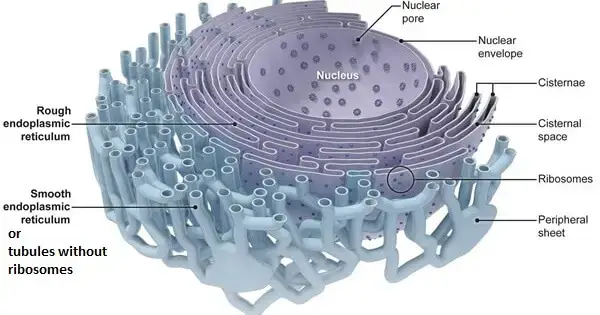
Lysosomes
Lysosomes are membrane-bound organelles found in almost all eukaryotic cells. They are crucial for cellular digestion, excretion, and renewal processes. Discovered by Belgian cytologist Christian René de Duve in the 1950s, lysosomes are often referred to as cell vesicles due to their vesicular nature.
Structure of Lysosomes:
- General Structure:
- Shape and Presence: Lysosomes are typically round and are distributed throughout the cytoplasm of eukaryotic cells.
- Membrane: Each lysosome is enclosed by a lipid bilayer membrane, which serves to isolate its acidic interior and digestive enzymes from the rest of the cell. This membrane is essential for maintaining the organelle’s internal environment and preventing damage to other cellular components.
- Acidity:
- Acidic Environment: Lysosomes maintain a highly acidic pH, which is crucial for the activity of their digestive enzymes. This acidic environment is created by proton pumps that actively transport hydrogen ions into the lysosome.
Functions of Lysosomes:
- Digestive Processes:
- Macromolecule Breakdown: Lysosomes are responsible for breaking down large macromolecules into simpler molecules that can be utilized by the cell. These macromolecules include proteins, carbohydrates, lipids, and nucleic acids.
- Proteins: Proteins are hydrolyzed into amino acids.
- Carbohydrates: Carbohydrates are broken down into simple sugars.
- Lipids: Lipids are converted into fatty acids and glycerol.
- Macromolecule Breakdown: Lysosomes are responsible for breaking down large macromolecules into simpler molecules that can be utilized by the cell. These macromolecules include proteins, carbohydrates, lipids, and nucleic acids.
- Cellular Waste Management:
- Degradation of Cellular Components: Lysosomes digest various cellular components such as old or damaged organelles (a process known as autophagy), cell waste products, and debris.
- Microorganism Degradation: In addition to cellular debris, lysosomes also digest engulfed microorganisms, playing a role in the cell’s defense mechanism.
- Excretion and Renewal:
- Nutrient Transport: After digestion, simpler molecules are transported into the cytoplasm where they are used for synthesizing new cellular materials.
- Cell Renewal: By degrading old cell parts and waste, lysosomes contribute to cellular renewal and homeostasis.
Enzymatic Activity:
- Hydrolytic Enzymes:
- Types of Enzymes: The digestive enzymes within lysosomes are known as hydrolytic enzymes or acid hydrolases. These enzymes are active only within the acidic environment of the lysosome.
- Function: These enzymes catalyze the breakdown of macromolecules into smaller, more manageable molecules that the cell can reuse.
- Protection Mechanism:
- Acidic Conditions: The acidity inside the lysosome protects the cell from self-digestion. Enzymes are activated only in the acidic environment of the lysosome, and any leakage into the neutral or slightly alkaline cytoplasm would not cause damage due to the inactivity of the enzymes outside the lysosome.
Golgi apparatus (Golgi bodies/Golgi complex)
The Golgi apparatus, also known as the Golgi bodies or Golgi complex, is a membrane-bound organelle located in the cytoplasm of eukaryotic cells. It functions as a central hub for the processing, modification, and transport of proteins and lipids within the cell.
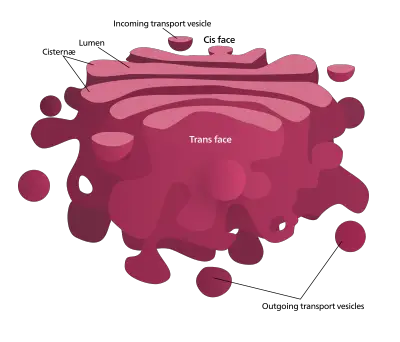
Structure of Golgi Apparatus:
- General Structure:
- Membranous Organization: The Golgi apparatus consists of a series of flattened, stacked pouches called cisternae. These cisternae are organized into a stack that is often located adjacent to the endoplasmic reticulum (ER) and near the cell nucleus.
- Cisternae: In animal cells, the Golgi apparatus typically contains between 4 to 10 cisternae, whereas some single-celled organisms may have up to 60 cisternae. Plant cells, on the other hand, may possess several hundred Golgi bodies.
- Compartments:
- Cis Face: The side of the Golgi apparatus nearest to the ER, where vesicles containing proteins and lipids arrive from the ER.
- Medial Cisternae: The central layers of the cisternae where the primary modifications of proteins and lipids occur.
- Trans Face: The side farthest from the ER, where modified proteins and lipids are sorted and packaged into vesicles for transport to their destination.
- Support Structure:
- Microtubules and Protein Matrix: Golgi bodies are supported by cytoplasmic microtubules and held together by a protein matrix, which aids in maintaining their structure and function.
Functions of Golgi Apparatus:
- Protein and Lipid Processing:
- Transport and Modification: The Golgi apparatus modifies proteins and lipids received from the ER and packages them into vesicles. These vesicles are then transported to specific destinations within or outside the cell.
- Modifications: Proteins and lipids undergo various modifications, such as the cleavage of oligosaccharide chains, attachment of sugar moieties, and addition of fatty acids or phosphate groups. These modifications occur as the molecules transit from the cis face to the trans face.
- Sorting and Packaging:
- Vesicular-Tubular Cluster: Proteins and lipids are first collected in vesicles that fuse with the cis Golgi network. These vesicles are transported through a vesicular-tubular cluster between the ER and the Golgi apparatus.
- Functional Units: As they progress through the Golgi, proteins and lipids are converted into functional units that are sorted in the trans-Golgi network. These functional units are then packaged into trans vesicles.
- Delivery and Exocytosis:
- Transport to Target Sites: The trans vesicles transport the modified proteins and lipids to various cellular destinations, including lysosomes or the cell membrane for exocytosis.
- Receptor-Mediated Transport: Some proteins are delivered to the cell membrane or lysosomes via receptor-mediated transport, which involves ligands binding to receptors and triggering vesicle fusion and secretion.
Cytoskeleton
The cytoskeleton is a complex network of fibrous proteins found in the cytoplasm of eukaryotic cells. It provides structural support, facilitates cellular movement, and organizes cellular components. The cytoskeleton is crucial for maintaining cell shape, enabling intracellular transport, and supporting various cellular functions.
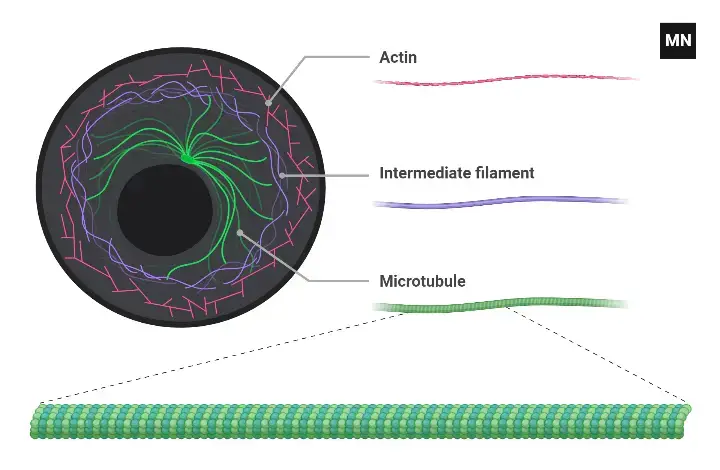
Structure of the Cytoskeleton:
- Composition:
- Proteins: The cytoskeleton is composed of various proteins that form long chains of amino acids, creating a fibrous network within the cell.
- Filaments: It consists of three primary types of filaments:
- Actin Filaments (Microfilaments)
- Microtubules
- Intermediate Filaments
- Types of Filaments:
- Actin Filaments (Microfilaments): These are thin, flexible fibers that form a meshwork just beneath the cell membrane. They are involved in maintaining cell shape, facilitating cell movement, and mediating various cellular processes.
- Microtubules: These are rigid, tubular structures that extend throughout the cell. They play a key role in cell division by helping to segregate chromosomes and also assist in intracellular transport.
- Intermediate Filaments: These are thicker than actin filaments and microtubules. They provide mechanical strength and stability, anchoring the nucleus and other organelles in place.
Functions of the Cytoskeleton:
- Structural Support:
- Cell Shape: The cytoskeleton maintains the cell’s shape by providing a structural framework. Actin filaments and intermediate filaments contribute significantly to this function.
- Cell Elasticity: Intermediate filaments enhance the cell’s ability to withstand physical stress and tension, contributing to cellular elasticity.
- Cellular Movement:
- Cell Motility: Actin filaments facilitate cell movement by polymerizing and depolymerizing, enabling processes such as crawling and changes in cell shape.
- Intracellular Transport: Microtubules serve as tracks for the movement of organelles, vesicles, and other cellular components. Motor proteins move along these tracks to deliver materials to various parts of the cell.
- Cell Division:
- Mitosis: During cell division, microtubules form the mitotic spindle, which is essential for separating chromosomes into the daughter cells. This ensures accurate chromosome distribution and successful cell division.
- Organization of Cell Components:
- Nucleus Positioning: Intermediate filaments help maintain the nucleus’s position within the cell, ensuring that it remains properly situated.
- Adherence and Cleavage: Actin filaments play a role in cell adherence to substrates and in cleavage during mitotic cell division.
Additional Proteins:
- Septin:
- Function: Septins are involved in assembling and organizing filament structures within the cytoskeleton. They contribute to the formation of septin filaments and help in cellular processes like cytokinesis.
- Spectrin:
- Function: Spectrin is a protein that helps maintain cell shape by linking the cell membrane to the underlying cytoskeleton. It is crucial for maintaining the structural integrity of the cell membrane.
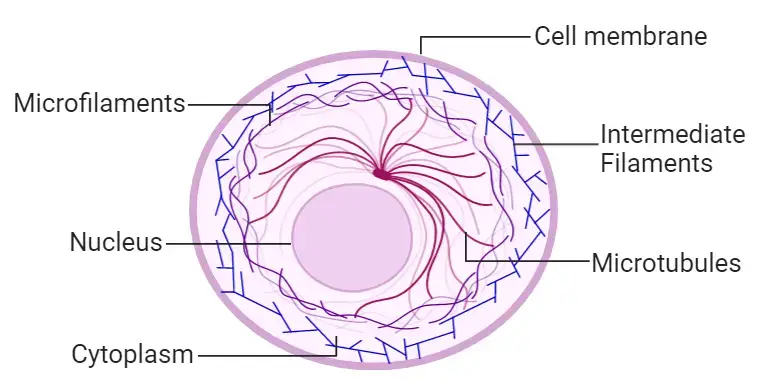
Centrioles
Centrioles are cylindrical cell structures found predominantly in animal cells. They play a crucial role in organizing microtubules and facilitating cell division. Each centriole is involved in the formation of the centrosome, which is integral to the mitotic process.
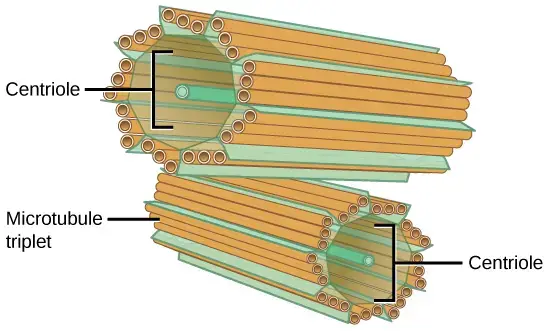
Structure of Centrioles:
- Composition:
- Microtubule Triplets: Centrioles consist of nine sets of microtubules arranged in triplets. Each triplet is a group of three microtubules positioned parallel to one another. This triplet arrangement provides structural stability and strength.
- Tubulin Subunits: The microtubules within centrioles are composed of tubulin subunits. These subunits polymerize to form long, hollow tubes that resemble straws, contributing to the overall structure of the centriole.
- Associated Components:
- Pericentriolar Matrix: Surrounding each centriole is the pericentriolar matrix, a protein-rich region that supports microtubule organization and assembly.
- Protein Connectors: Proteins hold the microtubules in their triplet arrangement, maintaining the centriole’s shape and functionality.
Functions of Centrioles:
- Microtubule Organization:
- Anchoring Microtubules: Centrioles serve as anchors for microtubules within the cell. They provide the base from which microtubules extend, playing a key role in maintaining the structural integrity of the cell’s cytoskeleton.
- Formation of Centrosome: Centrioles are essential components of the centrosome, a microtubule-organizing center that helps in the assembly and disassembly of microtubules.
- Cell Division:
- Mitosis and Centrosome Duplication: During cell division, each centriole duplicates to form a pair of centrioles. This results in the formation of two centrosomes, each consisting of a pair of centrioles oriented at right angles to each other.
- Spindle Fiber Formation: The microtubules extending from the centrosomes organize into spindle fibers. These fibers attach to chromosomes at their centromeres during mitosis and aid in the separation of chromosomes into daughter cells.
- Intracellular Transport:
- Substance Movement: Centrioles also facilitate the transport of substances within the cell. They assist in moving proteins and other cellular materials by linking with glycoproteins that act as signaling units, guiding these substances to specific locations.
Microtubules
Microtubules are a key component of the cytoskeleton in eukaryotic cells. These structures are essential for various cellular functions, including maintaining cell shape, facilitating intracellular transport, and supporting cell division.
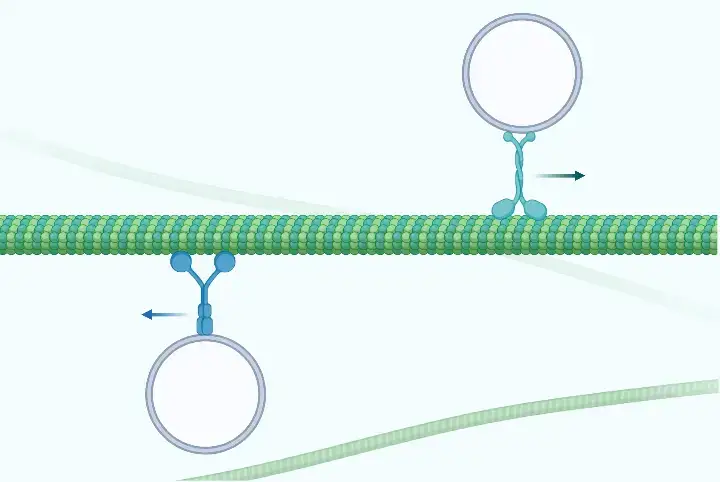
Structure of Microtubules:
- Composition:
- Subunits: Microtubules are long, straight, hollow cylinders composed of 13 to 15 parallel protofilaments. These protofilaments are made from tubulin, a globular protein.
- Tubulin: Tubulin is the protein subunit of microtubules, existing in two forms—alpha-tubulin and beta-tubulin. These subunits polymerize to form the protofilaments, which then assemble into the microtubule structure.
- Formation:
- Hollow Structure: Microtubules have a central lumen, distinguishing them from other filament types. This hollow cylinder structure is critical for their functions within the cell.
- Distribution: Microtubules extend throughout the cytoplasm of the cell, providing a framework for various cellular processes.
Functions of Microtubules:
- Intracellular Transport:
- Organelle Movement: Microtubules facilitate the transport of organelles, such as mitochondria and vesicles, within the cell. They act as tracks along which motor proteins, like kinesins and dyneins, move cargo to and from different cellular locations.
- Vesicle Transport: They are crucial for transporting vesicles, such as those involved in neurotransmission, from the neuron cell body to the axon terminals and vice versa.
- Structural Support:
- Support for Organelles: Microtubules provide structural support to organelles like the Golgi apparatus, anchoring them within the cytoplasmic gel matrix.
- Cell Shape: They contribute to the rigid and organized nature of the cytoskeleton, helping the cell maintain its shape and resist deformation.
- Cell Motility:
- Locomotion: Microtubules are fundamental components of cilia and flagella, which are locomotive projections of the cell. These structures are essential for cellular movement and the movement of fluids across the cell surface.
- Cell Division:
- Spindle Formation: During mitosis, microtubules form the mitotic spindle, a structure that segregates chromosomes into the daughter cells. This process ensures that each new cell receives an accurate copy of the genetic material.
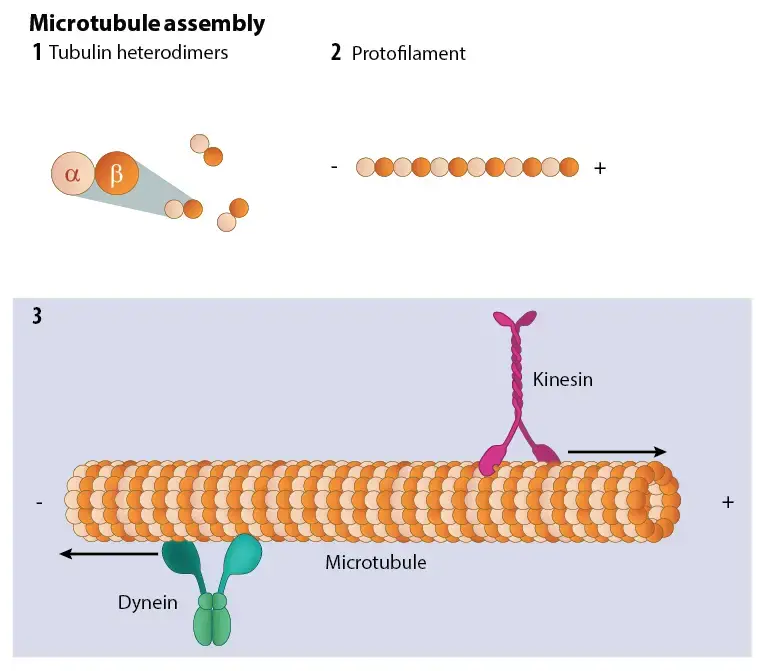
Peroxisomes
Peroxisomes are small, membrane-bound organelles located in the cytoplasm of eukaryotic cells. They are crucial for various metabolic processes and detoxification pathways within the cell.
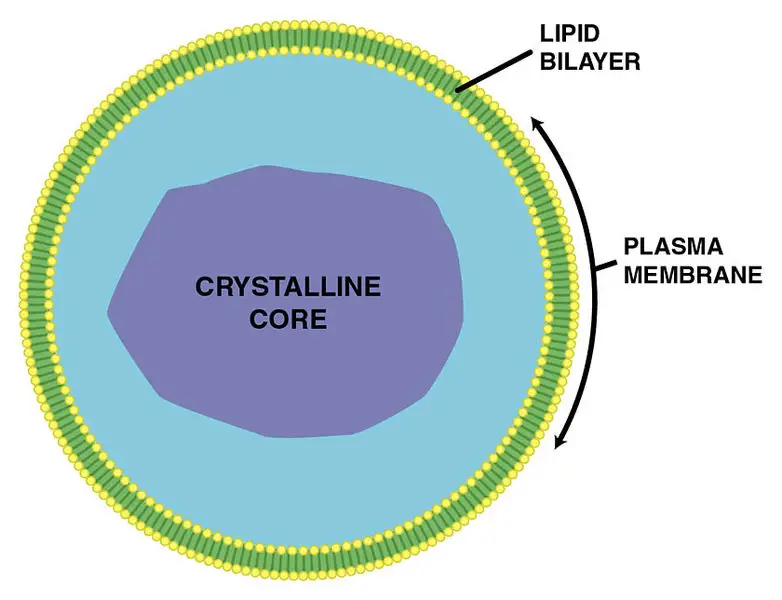
Structure of Peroxisomes:
- Shape and Membrane:
- Spherical Form: Peroxisomes are generally spherical or oval in shape.
- Membrane Boundary: They are enclosed by a single lipid bilayer membrane, which helps to compartmentalize their internal environment from the surrounding cytoplasm.
- Micro-body Classification:
- Common Micro-bodies: Peroxisomes are among the most prevalent micro-bodies found in the cytoplasm, alongside other organelles such as lysosomes and mitochondria.
Functions of Peroxisomes:
- Lipid Metabolism:
- Fatty Acid Oxidation: Peroxisomes are involved in the breakdown of long-chain fatty acids through β-oxidation. This process converts fatty acids into acetyl-CoA, which can then enter the mitochondria for further metabolism.
- Bile Acid Synthesis: They play a role in the synthesis of bile acids from cholesterol, which is important for digestion and absorption of dietary fats.
- Chemical Detoxification:
- Hydrogen Peroxide Production: Peroxisomes facilitate the detoxification of harmful substances by transferring hydrogen atoms from various molecules to oxygen, producing hydrogen peroxide (H₂O₂) in the process.
- Detoxification of Alcohol: Specifically, in the liver, peroxisomes help to neutralize toxins such as alcohol through the production of hydrogen peroxide, which is subsequently broken down by catalase into water and oxygen.
- Reactive Oxygen Species (ROS) Management:
- ROS Regulation: Peroxisomes are essential in managing reactive oxygen species (ROS), which are byproducts of various metabolic processes. The organelles contain enzymes, such as catalase, that neutralize excess ROS, thus preventing cellular damage.
Endosome
Endosomes are membrane-bound vesicles found within the cytoplasm of eukaryotic cells. They play a crucial role in cellular processes such as internalization and trafficking of extracellular materials.
Structure of Endosomes:
- Membranous Organelles:
- Membrane Composition: Endosomes are characterized by their membrane-bound structure. They are formed by the invagination of the plasma membrane, creating a vesicle that contains various substances from the extracellular space.
- Location: They are located within the cell cytoplasm, where they interact with other cellular organelles to perform their functions.
- Formation:
- Endocytosis: Endosomes are formed through the process of endocytosis, where the plasma membrane folds inward to engulf extracellular materials. This process results in the creation of a vesicle that is enclosed by a lipid bilayer.
Functions of Endosomes:
- Internalization of Extracellular Materials:
- Molecular Transport: Endosomes facilitate the internalization of extracellular molecules by folding the plasma membrane to form vesicles. These vesicles transport substances such as nutrients, signaling molecules, and other extracellular components into the cell.
- Types of Endocytosis:
- Exocytosis: The process through which endosomes fuse with the plasma membrane to release their contents outside the cell.
- Phagocytosis: The mechanism by which endosomes engulf larger particles or cells, such as pathogens or debris, for internal processing and degradation.
- Waste Removal:
- Cellular Cleanup: One of the primary roles of endosomes is to remove waste materials from the cell. This involves the uptake of cellular debris and unwanted substances through endocytic processes, which are subsequently processed and expelled by exocytosis or lysosomal degradation.
- Recycling: Endosomes also play a role in recycling membrane components and other molecules back to the plasma membrane or other cellular compartments.
Cilia and Flagella
Cilia and flagella are cellular projections that extend from the surface of various eukaryotic cells. They are involved in locomotion and the movement of fluids across cell surfaces.
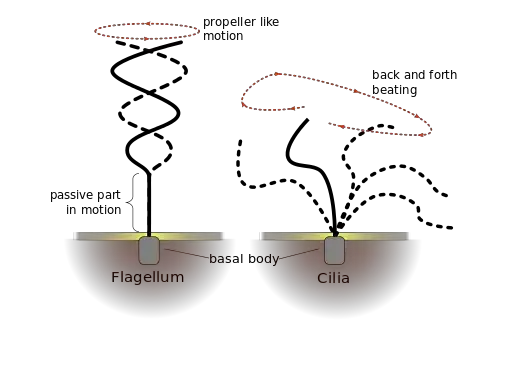
Structure of Cilia and Flagella:
- Filament Composition:
- Microtubule Arrangement: Both cilia and flagella are constructed from microtubules, which are long, thin protein filaments. These microtubules are organized into specific patterns within the projections.
- Partial and Complete Microtubules:
- Complete Microtubules: Extend from the base to the tip of the projection.
- Partial Microtubules: Extend partially within the projection, not reaching the tip.
- Motor Proteins:
- Dynein: Motor proteins known as dynein are interspersed between the partial and complete microtubules. Dynein facilitates movement by enabling sliding between microtubules, which is essential for the bending and beating motion of cilia and flagella.
- Plasma Membrane Integration:
- Extension of Plasma Membrane: Cilia and flagella extend from the plasma membrane of the cell, and the entire structure is enclosed within this membrane, integrating with the cell’s outer boundary.
Functions of Cilia and Flagella:
- Locomotion:
- Flagella: In sperm cells, flagella provide propulsion, enabling these cells to swim towards an ovum for fertilization. The flagellum moves in a whip-like motion, driving the sperm cell forward.
- Single-cell Movement: For single-celled organisms, such as some protozoa, flagella enable swimming by undulating and propelling the cell through its environment.
- Fluid Movement:
- Cilia: In multicellular organisms, cilia on the surface of certain cells help to move fluids and particles across the cell surface. For instance, cilia in the respiratory tract move mucus and trapped particles away from the lungs and towards the throat.
- Epithelial Lining: On epithelial cells, cilia assist in moving surface particles and fluids, contributing to processes such as the clearing of mucus from the respiratory tract.
Microvilli
Microvilli are microscopic, finger-like projections that extend from the surface of various cells. They are prominent in specific tissues where they serve crucial functions related to absorption, signal transduction, and cellular adhesion.
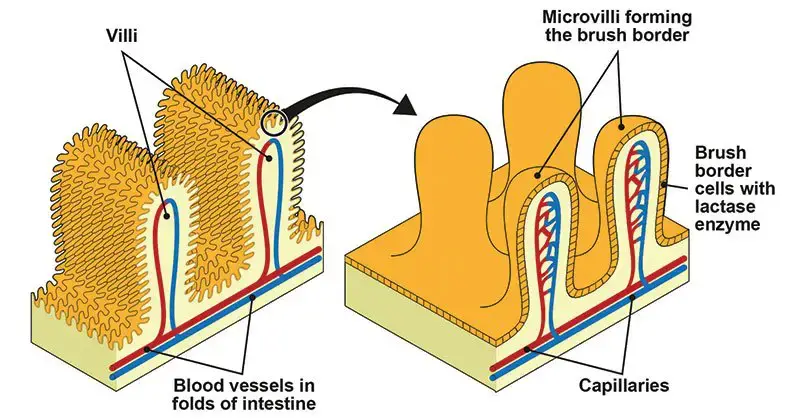
Structure of Microvilli:
- Formation:
- Actin Filaments: Microvilli are supported by bundles of actin filaments, which are integral components of the cell’s cytoskeleton. These filaments provide structural support and stability to the protrusions.
- Accessory Proteins: Accessory proteins associated with actin filaments help in bundling and anchoring the microvilli. These proteins facilitate the formation and maintenance of the microvilli’s structure.
- Surface Protrusions:
- Cell Membrane Extensions: Microvilli are extensions of the cell membrane. They increase the cell’s surface area, allowing for enhanced interactions with the surrounding environment.
Functions of Microvilli:
- Absorption:
- Intestinal Lining: In the small intestine, microvilli play a critical role in digestion by vastly increasing the surface area available for the absorption of nutrients and water from digested food. This structural adaptation enhances the efficiency of nutrient uptake.
- Increased Surface Area: The extensive array of microvilli ensures that a larger surface area is available for absorption, optimizing the digestive process.
- Sensory Functions:
- Auditory Detection: Microvilli located in the inner ear contribute to the detection of sound. They are involved in converting sound waves into electrical signals that are transmitted to the brain for auditory processing.
- Signal Transmission: The microvilli in the ear facilitate the transduction of sound waves into electrical signals, playing a key role in auditory perception.
- Reproductive Function:
- Sperm-Egg Interaction: Microvilli on the surface of egg cells help anchor sperm cells, thereby aiding in fertilization. They provide a surface for sperm attachment and interaction, facilitating successful fertilization.
- Immune Response:
- White Blood Cells: Microvilli on white blood cells function as anchors, enabling these cells to adhere to and move within the circulatory system. This adhesion capability is crucial for the immune cells to reach and interact with pathogens or damaged tissues.
- Cell Movement and Adhesion: By anchoring white blood cells, microvilli assist in their effective navigation through the bloodstream, enhancing their ability to locate and respond to potential threats.
Vacuoles
Vacuoles are fluid-filled organelles enclosed by a membrane, present in the cytoplasm of eukaryotic cells. They play a critical role in maintaining cellular homeostasis and performing various functions crucial to cell survival and efficiency.
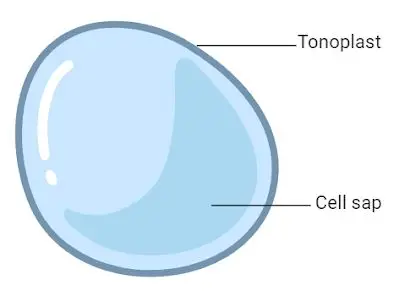
Structure of Vacuoles:
- Membrane-Bound Sacs:
- Enclosing Membrane: Vacuoles are enclosed by a single membrane known as the tonoplast. This membrane is similar in structure to the plasma membrane, comprising a lipid bilayer that separates the vacuole’s internal environment from the cytoplasm.
- Fluid-Filled Interior: The interior of the vacuole is filled with a fluid that can include water, nutrients, and waste products. The composition of this fluid varies depending on the vacuole’s function and the cell type.
- Membrane Composition:
- Tonoplast: The tonoplast regulates the movement of ions, small molecules, and proteins into and out of the vacuole. It contains specific transport proteins that manage the selective permeability of the vacuole.
Functions of Vacuoles:
- Storage:
- Nutrient Storage: Vacuoles store essential nutrients such as sugars and carbohydrates. This storage function is vital for energy regulation and availability within the cell.
- Water Storage: They maintain water balance by accumulating or releasing water as needed, thus contributing to cellular turgor pressure.
- Waste Storage: Vacuoles sequester waste products and toxic substances, preventing their accumulation in the cytoplasm and facilitating their removal from the cell.
- Regulation and Protection:
- Selective Permeability: The tonoplast controls the inflow and outflow of substances, ensuring that only specific molecules pass through. This regulation helps maintain the proper chemical environment within the vacuole.
- Detoxification: By sequestering toxic compounds, vacuoles protect the cell from potentially harmful substances. They also assist in breaking down these toxins into less harmful forms.
- Protein Quality Control:
- Protein Removal: Vacuoles are involved in the removal of poorly folded or misfolded proteins. This function is part of the cell’s quality control mechanisms, ensuring that only properly folded proteins are retained.
- Adaptability:
- Shape and Size Changes: Vacuoles can adjust their shape and size in response to cellular needs. This adaptability allows them to fulfill various roles depending on the cell’s physiological state and environmental conditions.
Animal Cell Summary Tables
Locations of Different Organelles within the Animal Cell
| Organelle | Location within the cell |
|---|---|
| Plasma membrane (Cell membrane) | Outermost boundary of the cell, surrounds the cytoplasm |
| Nucleus | Central, usually spherical organelle that contains the cell’s genetic material (DNA) |
| Cytoplasm | Semi-fluid matrix that contains all the cell’s organelles and is bounded by the plasma membrane |
| Mitochondria | Scattered throughout the cytoplasm, the powerhouses of the cell, involved in cellular respiration |
| Ribosomes | Found free in the cytoplasm or attached to the endoplasmic reticulum (ER), involved in protein synthesis |
| Endoplasmic Reticulum (ER) | Network of flattened, interconnected sacs that run throughout the cytoplasm, involved in protein synthesis and lipid metabolism |
| Golgi apparatus (Golgi bodies/Golgi complex) | Usually found near the nucleus, involved in the modification, sorting and packaging of proteins and lipids |
| Lysosomes | Small, membrane-bound organelles scattered throughout the cytoplasm, involved in the degradation and recycling of cellular waste and nutrients |
| Cytoskeleton | Network of protein filaments that provides shape, structure, and support to the cell |
| Microtubules | Composed of protein tubulin, found throughout the cytoplasm, involved in cell division, maintenance of cell shape and movement of organelles |
| Centrioles | Found near the nucleus, involved in cell division and the formation of cilia and flagella |
| Peroxisomes | Small, membrane-bound organelles scattered throughout the cytoplasm, involved in fatty acid oxidation and the breakdown of harmful substances |
| Cilia and Flagella | Thin, hair-like projections from the cell surface, involved in movement and sensory reception |
| Endosome | Vesicles formed from the Golgi apparatus, involved in the internalization of materials from the cell surface |
| Vacuoles | Large, fluid-filled organelles found in plant and some fungal cells, involved in storage and waste management |
| Microvilli | Tiny, finger-like projections from the surface of some cells, involved in increased surface area for absorption or secretion. |
Functions of Different Organelles within the Animal Cell
| Organelle | Function |
|---|---|
| Plasma membrane (Cell membrane) | Controls the exchange of substances between the cell and its surroundings, regulates the passage of materials in and out of the cell. |
| Nucleus | Control center of the cell, contains genetic material (DNA) and coordinates the functions of the cell. |
| Cytoplasm | Jelly-like substance that surrounds the nucleus and contains other organelles. |
| Mitochondria | Powerhouses of the cell, responsible for producing energy. |
| Ribosomes | Site of protein synthesis. |
| Endoplasmic Reticulum (ER) | Network of tubes and flattened sacs involved in the synthesis, modification and transport of proteins and lipids. |
| Golgi apparatus (Golgi bodies/Golgi complex) | Modifies, sorts and packages proteins and lipids for storage and transport. |
| Lysosomes | Contain digestive enzymes, break down waste and cellular debris. |
| Cytoskeleton | Provides structural support to the cell and helps maintain its shape. |
| Microtubules | Form part of the cytoskeleton, involved in cell division and maintenance of cell shape. |
| Centrioles | Involved in the formation of cilia and flagella and play a role in cell division. |
| Peroxisomes | Contain enzymes that detoxify harmful substances and break down fatty acids. |
| Cilia and Flagella | Hair-like structures that help the cell move or move substances over its surface. |
| Endosome | Vesicles that carry substances internalized from the plasma membrane for further processing. |
| Vacuoles | Storage compartments for food, waste and other materials. |
| Microvilli | Tiny finger-like projections on the surface of a cell, increase surface area for the absorption of nutrients. |
Important Points to Note About Animal Cell
Animal cells are fundamental units of life in multicellular organisms. Their structure and functions are essential for the diverse activities that sustain life. The following points highlight key aspects of animal cells:
- Basic Structural and Functional Unit:
- Cell Definition: A cell is the smallest unit of life that can carry out all the functions necessary for survival. It serves as the basic building block for all living organisms.
- Types of Cells: Cells are categorized into two primary types: prokaryotic and eukaryotic. Animal cells are examples of eukaryotic cells, which are characterized by their complex internal structures and organelles.
- Eukaryotic Nature:
- Shared Characteristics: Both plant and animal cells are eukaryotic, meaning they have a nucleus and other membrane-bound organelles. Despite their similarities, animal and plant cells have distinct features.
- Cell Membrane: Eukaryotic cells are enclosed by a plasma membrane that regulates the movement of substances in and out of the cell.
- Absence of Cell Wall:
- Flexibility in Shape: Unlike plant cells, animal cells lack a rigid cell wall. The absence of this structure allows animal cells to have more flexibility in shape and movement.
- Cell Shape and Movement: This flexibility facilitates various functions such as cell migration, shape changes, and phagocytosis.
- Lack of Chloroplasts:
- Photosynthesis: Animal cells do not contain chloroplasts and therefore cannot perform photosynthesis. Chloroplasts, which are found in plant cells, are responsible for converting light energy into chemical energy.
- Energy Acquisition: Instead, animal cells obtain energy through the consumption of organic matter and the process of cellular respiration in mitochondria.
- Diverse Structures and Functions:
- Specialization: Animal cells exhibit a wide range of structures and functions tailored to their specific roles in various tissues and organs. This specialization allows cells to perform specific tasks efficiently.
- Examples of Specialization:
- Muscle Cells: Adapted for contraction and movement.
- Neurons: Specialized for transmitting electrical signals.
- Epithelial Cells: Form protective layers and facilitate absorption and secretion.
- Examples of Specialization:
- Specialization: Animal cells exhibit a wide range of structures and functions tailored to their specific roles in various tissues and organs. This specialization allows cells to perform specific tasks efficiently.
Functions of Animal Cell
Animal cells, as fundamental units of life in multicellular organisms, perform a variety of essential functions that ensure cellular and overall organismal viability. The following points outline the key functions of animal cells:
- Energy Production:
- Mitochondria: Often referred to as the “powerhouses” of the cell, mitochondria are responsible for generating adenosine triphosphate (ATP) through cellular respiration. This process converts nutrients into energy, which is crucial for various cellular activities.
- Cellular Respiration: Involves a series of biochemical reactions, including glycolysis, the citric acid cycle, and oxidative phosphorylation, culminating in the production of ATP.
- Energy Currency: ATP acts as the primary energy currency of the cell, driving processes such as metabolism, muscle contraction, and cell division.
- Mitochondria: Often referred to as the “powerhouses” of the cell, mitochondria are responsible for generating adenosine triphosphate (ATP) through cellular respiration. This process converts nutrients into energy, which is crucial for various cellular activities.
- Regulation of Cellular Environment:
- Plasma Membrane: The plasma membrane, or cell membrane, regulates the entry and exit of substances, thereby maintaining cellular homeostasis. It is a selectively permeable barrier composed of a lipid bilayer with embedded proteins.
- Selective Permeability: Controls the passage of ions, nutrients, and waste products, ensuring the internal environment remains stable.
- Transport Mechanisms: Includes passive transport (e.g., diffusion and osmosis) and active transport (e.g., sodium-potassium pump) to facilitate the movement of molecules.
- Plasma Membrane: The plasma membrane, or cell membrane, regulates the entry and exit of substances, thereby maintaining cellular homeostasis. It is a selectively permeable barrier composed of a lipid bilayer with embedded proteins.
- Genetic Information and Regulation:
- Nucleus: The nucleus houses the cell’s DNA, which encodes the genetic instructions necessary for cellular function and replication. It regulates cellular activities through processes of transcription and translation.
- DNA Storage: Contains genetic material organized into chromosomes, which guide protein synthesis and cell function.
- Gene Expression: Transcription of DNA into messenger RNA (mRNA) and subsequent translation into proteins regulate cell activities and respond to environmental signals.
- Nucleus: The nucleus houses the cell’s DNA, which encodes the genetic instructions necessary for cellular function and replication. It regulates cellular activities through processes of transcription and translation.
- Protein Synthesis and Processing:
- Endoplasmic Reticulum (ER): The ER is involved in the synthesis and processing of proteins and lipids. It exists in two forms: rough ER, studded with ribosomes for protein synthesis, and smooth ER, involved in lipid synthesis and detoxification.
- Rough ER: Synthesizes proteins destined for secretion, incorporation into the cell membrane, or lysosomal use.
- Smooth ER: Involved in lipid metabolism and the detoxification of harmful substances.
- Golgi Apparatus: The Golgi apparatus modifies, sorts, and packages proteins and lipids received from the ER for transport to their final destinations.
- Post-Translational Modification: Proteins undergo modifications such as glycosylation and phosphorylation.
- Vesicle Formation: Packages molecules into vesicles for secretion or delivery to other organelles.
- Endoplasmic Reticulum (ER): The ER is involved in the synthesis and processing of proteins and lipids. It exists in two forms: rough ER, studded with ribosomes for protein synthesis, and smooth ER, involved in lipid synthesis and detoxification.
- Cell Division and Organization:
- Centrioles: Centrioles are critical for organizing microtubules during cell division. They form the centrosome, which orchestrates the assembly and disassembly of microtubules.
- Microtubule Organization: Ensures proper alignment and separation of chromosomes during mitosis and meiosis.
- Spindle Formation: Facilitates chromosome segregation by forming the mitotic spindle.
- Centrioles: Centrioles are critical for organizing microtubules during cell division. They form the centrosome, which orchestrates the assembly and disassembly of microtubules.
- Homeostasis and Cellular Coordination:
- Cellular Homeostasis: Animal cells work collaboratively to maintain a stable internal environment. This is crucial for the health and function of the organism as a whole.
- Signal Transduction: Cells communicate through signaling pathways to coordinate responses and maintain equilibrium.
- Adaptation: Cells adjust their functions and structures in response to changes in their internal and external environments.
- Cellular Homeostasis: Animal cells work collaboratively to maintain a stable internal environment. This is crucial for the health and function of the organism as a whole.
What are the differences between animal and plant cells?
Differences between Animal and Plant Cells:
| Characteristic | Animal Cell | Plant Cell |
|---|---|---|
| Cell Wall | No cell wall | Cell wall present |
| Cell Shape | Mostly irregular shape | Usually rectangular or square shape |
| Vacuoles | Small, multiple vacuoles | Large, single central vacuole |
| Chloroplasts | No chloroplasts | Chloroplasts present |
| Mitochondria | Abundant mitochondria | Fewer mitochondria |
| Endoplasmic Reticulum | Rough and smooth ER present | Rough ER present |
| Golgi Apparatus | Typically larger Golgi complex | Typically smaller Golgi complex |
| Nucleus | One central, rounded nucleus | One central, rounded nucleus |
| Cytoskeleton | Microfilament-based cytoskeleton | Microfilament and microtubule-based cytoskeleton |
Animal and plant cell diagram
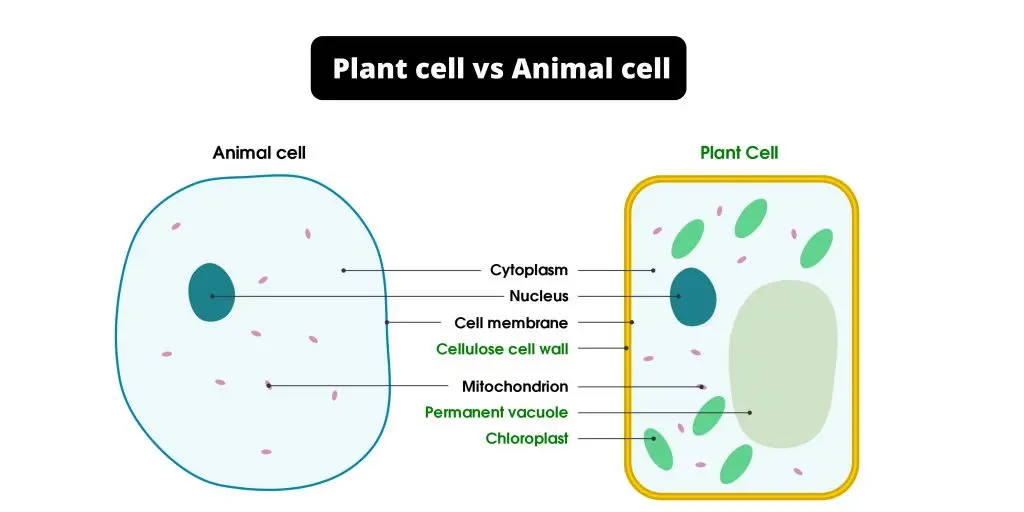
Animal Cell Animation Video Lecture
FAQ on Animal Cell
What is an animal cell?
Animal cells, as their name suggests, are a type of cell found exclusively in animal tissues. It is characterised by the lack of a cell wall and the encapsulation of cell organelles within the cell membrane.
Which cell organelle is responsible for the generation of energy for cellular activities?
Mitochondria is responsible for the generation of energy for cellular activities
Name the double-layered membrane responsible for enveloping the nucleus.
Nuclear envelope is the double-layered membrane responsible for enveloping the nucleus.
Name the cell organelle that contains the genetic material of the cell.
Nucleus contains the genetic material of the cell
What is the role of lysosomes?
Lysosomes help in digestion, excretion and cell renewal process.
State the various types of animal cells.
Skin Cells
Muscle Cells
Blood Cells
Nerve cells
Fat Cells
Explain how an animal cell varies from a plant cell.
Typically, an animal cell is irregular and spherical in shape. This is mostly attributable to the absence of the cell wall, a characteristic of plant cells. Additionally, animal cells lack plastids since animals are not autotrophs.
Name the selectively permeable structure that envelopes the entire cell.
Cell membrane is the selectively permeable structure that envelopes the entire cell.
Which cell organelle is responsible for packing?
Golgi apparatus is responsible for packing
What are animal cells called?
Eukaryotic Cell
What is animal cell and function?
Animal cells are the fundamental components of all Animalia kingdom living beings. They provide structure, absorb nutrients for energy conversion, and facilitate movement. They also contain all of an organism’s genetic material and can replicate themselves.
What shape is an animal cell?
Animal cells are predominantly spherical and variable in shape, whereas plant cells are rectangular and fixed. As eukaryotic cells, plant and animal cells have key characteristics, including the presence of a cell membrane and organelles such as the nucleus, mitochondria, and endoplasmic reticulum.
What does a animal cell look like?
The majority of animal cells are spherical and variable in shape, whereas plant cells are rectangular and stable. Plant and animal cells are both eukaryotic, meaning they share characteristics such as the presence of a cell membrane and organelles such as the nucleus, mitochondria, and endoplasmic reticulum.
What does the nucleolus do in an animal cell?
The nucleolus is a spherical structure found in the nucleus of a cell that is responsible for producing and assembling ribosomes. Additionally, ribosomal RNA genes are transcribed in the nucleolus.
How does the shape of a plant cell differ from that of an animal cell?
Plant cells have a defined shape, often rectangular or square with rounded corners, due to the presence of a rigid cell wall. Animal cells lack this cell wall and tend to have a more amorphous, irregular shape.
Animal Cell Worksheet
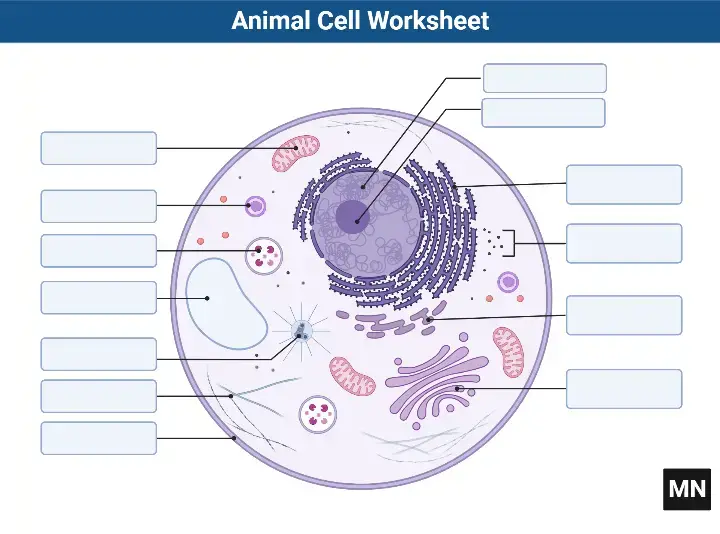
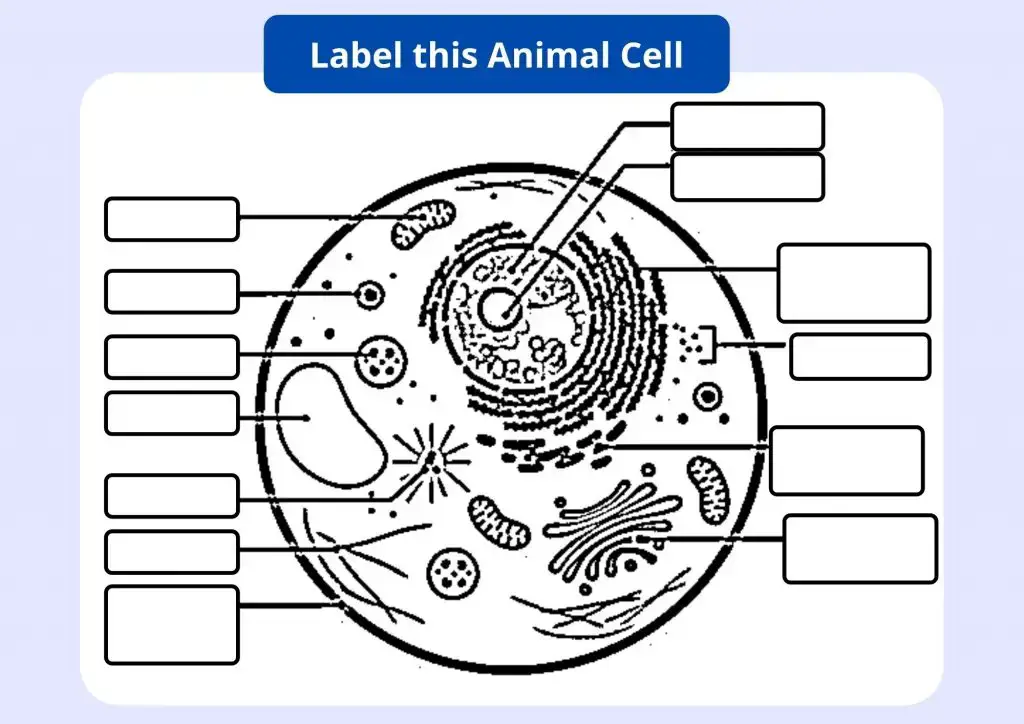
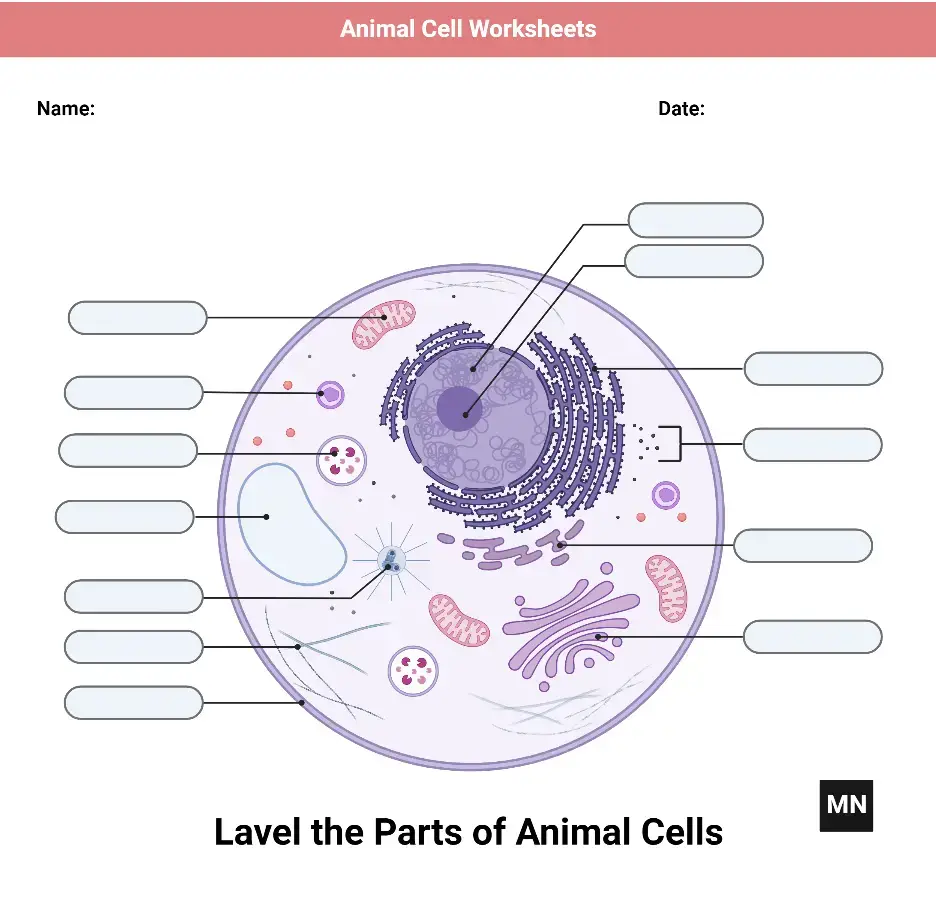
Cell Membrane (Plasma Membrane) Worksheet
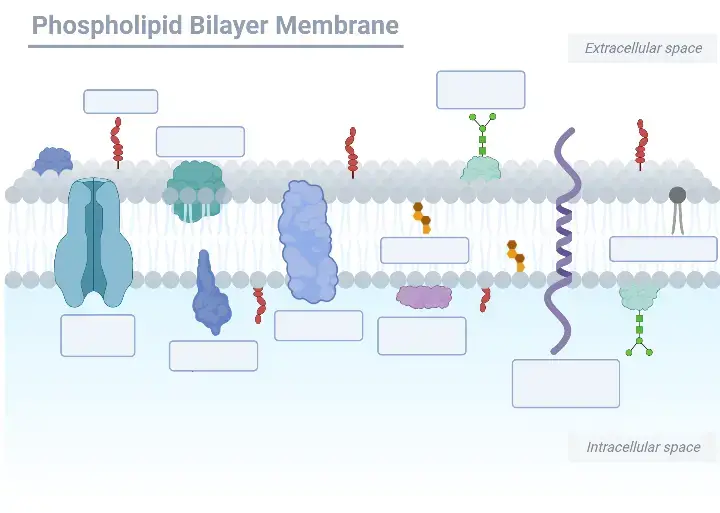
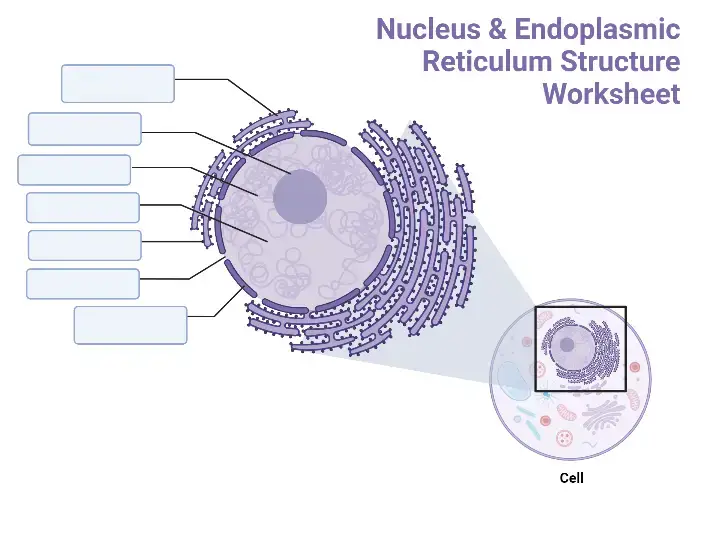
Nucleus & Endoplasmic Reticulum Structure 3D Worksheet
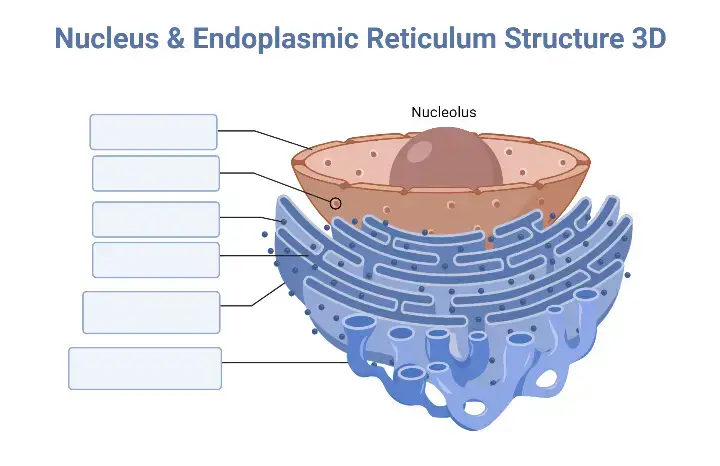
Mitochondria Structure Animal Cell worksheet
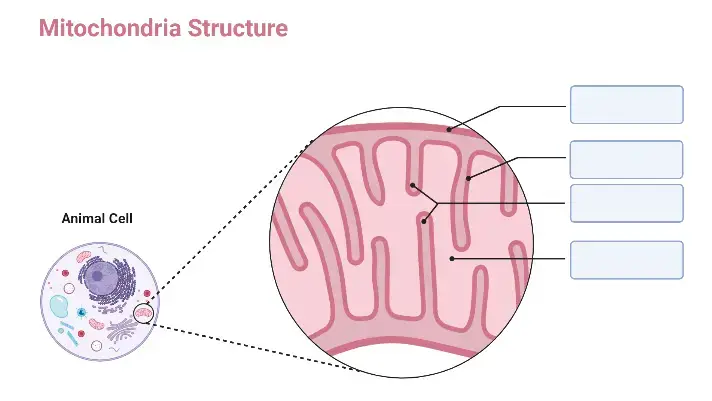
Ribosome Structure Worksheet
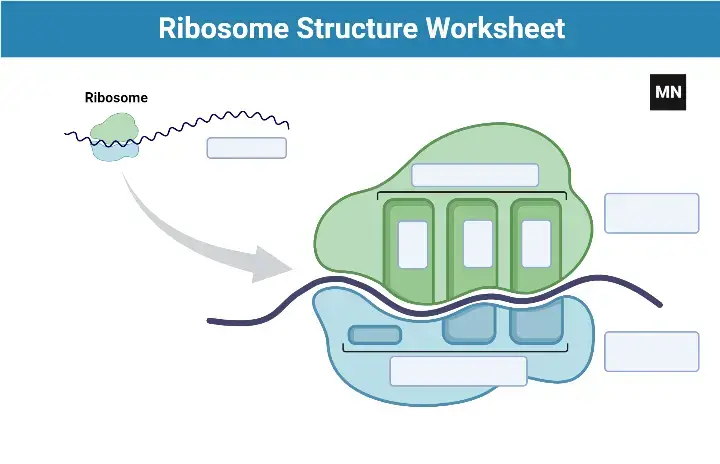
Cytoskeleton Components (Fluorescent) Worksheet
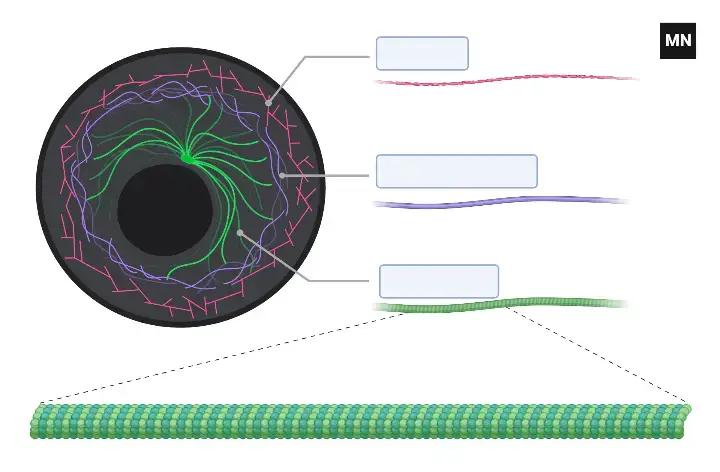
Reference
- https://askabiologist.asu.edu/cell-parts
- Molecular Expressions Cell Biology https://micro.magnet.fsu.edu/cells/animalcell.html
- Lab Manual Exercise # 1a. (2012). https://www2.palomar.edu/users/warmstrong/lmexer1a.htm
- Animal Cell – The Almighty Cell. (2019). Animal Cell – The Almighty Cell. https://sites.google.com/a/asu.edu/the-almighty-cell/the-source/animal-cell
- Plant and Animal Cells Grade 4 Unit 3 Lesson 1. (n.d.). https://coast.noaa.gov/data/SEAMedia/Presentations/PDFs/Grade 4 Unit 3 Lesson 1 Plant & Animal Cells.pdf
- Cell Structure and Function. (2019). https://msu.edu/~potters6/te801/Biology/biounits/cellstructure&function.htm
- https://micro.magnet.fsu.edu/cells/animalcell.html
- https://training.seer.cancer.gov/anatomy/cells_tissues_membranes/cells/structure.html
- https://study.com/academy/lesson/the-cell-structure-function.html
- https://courses.lumenlearning.com/wm-nmbiology1/chapter/animal-cells-versus-plant-cells/
- https://www.biologyonline.com/dictionary/animal-cell
- https://opentextbc.ca/biology/chapter/3-3-eukaryotic-cells/
- http://www.biology4kids.com/files/cell_main.html
- https://www.thoughtco.com/all-about-animal-cells-373379
- https://courses.lumenlearning.com/wm-biology1/chapter/reading-unique-features-of-plant-cells/
- https://www.pw.live/exams/school/animal-cells/
- https://www.bbc.co.uk/bitesize/articles/zkm7wnb#z9hdh4j
- https://www.geeksforgeeks.org/animal-cell/
Excellent Article
Thank You